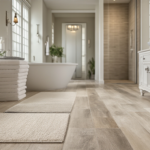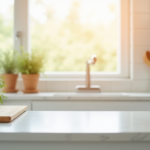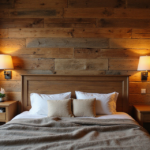Walking up to a home should feel like an invitation—a gentle prelude to the warmth and character that lies within. Yet too often, front yards become afterthoughts, neglected canvases that fail to capture the true spirit of the homes they frame. Your front yard isn’t just the space between the sidewalk and your door; it’s your home’s first handshake, its opening statement, and perhaps most importantly, a reflection of the care and creativity that flows through your daily life.
The most captivating front yards I’ve encountered in my years of vintage modern revival work share a common thread: they tell stories that span generations while embracing contemporary sensibilities. Whether it’s a carefully restored mid-century planter that now cradles drought-tolerant succulents or a heritage rose garden that’s been updated with modern irrigation, these spaces honor the past while serving today’s lifestyle needs. The beauty lies not in following rigid formulas, but in understanding how thoughtful design choices can create spaces that feel both timeless and thoroughly current.
These 22 transformative front yard ideas represent more than mere landscaping suggestions—they’re invitations to reimagine your outdoor space as an extension of your home’s story. From smart mowing techniques that create lush, resilient lawns to strategic lighting that transforms evening curb appeal, each approach offers practical solutions wrapped in design wisdom. Let’s explore how small changes can yield remarkable transformations, creating front yards that welcome guests while reflecting the unique character of the families who call these houses home.
1. Create Lush Green Foundations with Strategic Mowing Techniques
The secret to a truly magnificent lawn lies not in expensive treatments or complicated schedules, but in understanding how your mower can become a tool for cultivating resilience. After years of working with homeowners who’ve inherited everything from pristine Kentucky bluegrass to patchy suburban lawns, I’ve learned that the most vibrant grass comes from techniques that encourage deep root systems and natural density. When you mow taller—maintaining grass at 3 to 3.5 inches rather than the typical scalped appearance—you’re essentially training your lawn to develop the kind of robust foundation that weathers drought, resists weeds, and maintains that coveted emerald richness throughout the seasons.
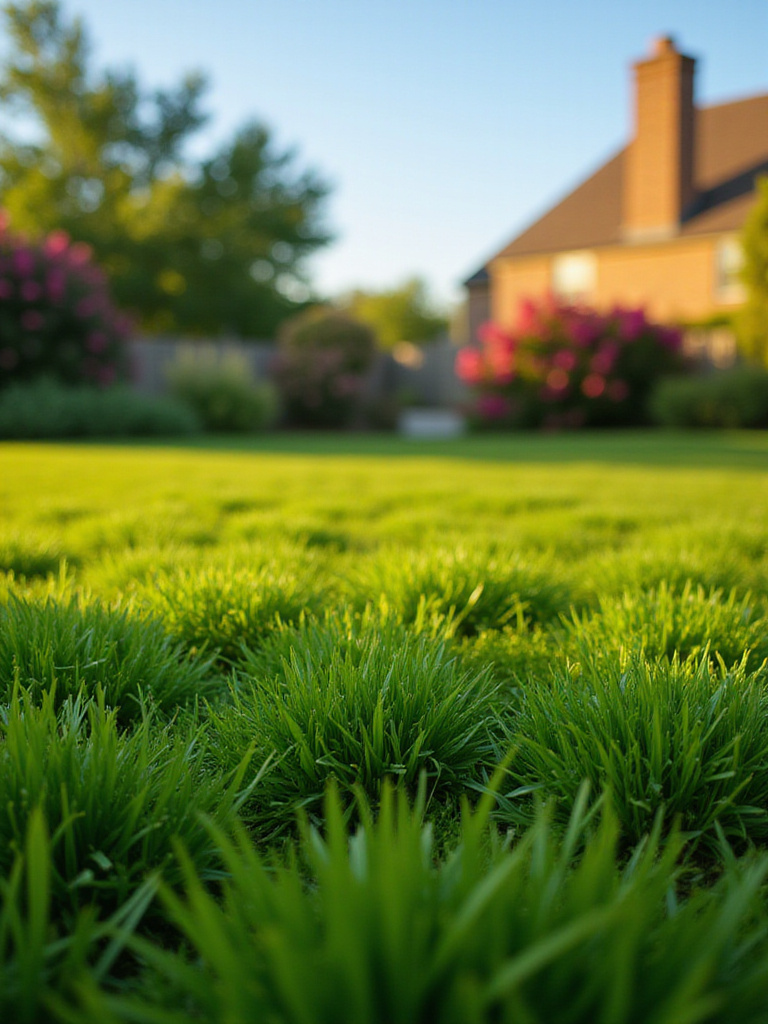
The transformation happens gradually but unmistakably. Taller grass blades capture more sunlight for photosynthesis, which fuels deeper root development and creates a natural canopy that shades out weed seeds before they can establish. This approach reduces your reliance on chemical interventions while building a lawn that can reduce watering needs by up to 20% during dry spells. The key lies in never removing more than one-third of the blade length in a single cutting, keeping your mower blades sharp enough to make clean cuts rather than tears, and embracing the practice of leaving grass clippings to decompose naturally back into the soil.
What makes this approach particularly compelling is how it honors both traditional lawn care wisdom and modern environmental consciousness, creating spaces that feel both meticulously maintained and naturally sustainable.
2. Define Garden Boundaries with Crisp, Clean Edging
The difference between a garden that looks professionally maintained and one that appears slightly unkempt often comes down to edges—those precise lines that separate lawn from planting beds, pathways from planted areas. In my restoration work, I’ve seen how the simple act of creating defined boundaries can transform a scattered collection of plants into a cohesive landscape narrative. Whether you choose natural stone that echoes your home’s foundation materials, classic brick that complements traditional architecture, or sleek metal edging for contemporary spaces, the goal is creating visual order that guides the eye and contains the practical elements of your garden.
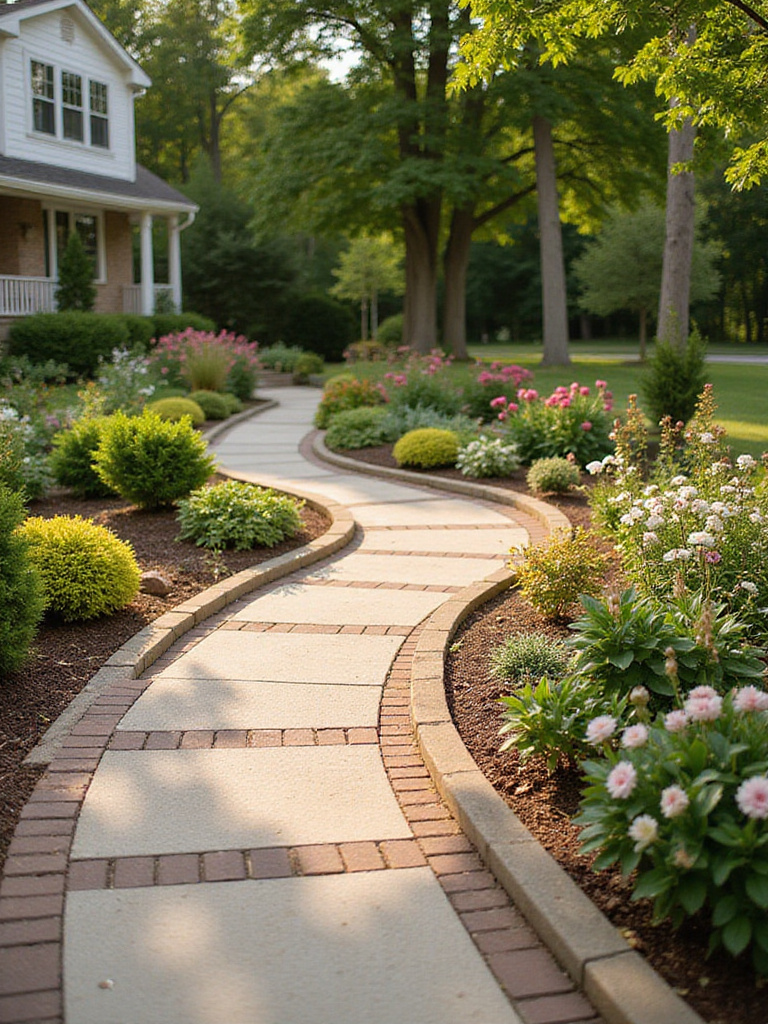
Beyond aesthetics, proper edging serves as a hardworking boundary that prevents grass from creeping into flower beds and keeps mulch contained where it belongs. This containment reduces maintenance time significantly—no more tedious hand-weeding where lawn meets garden, no more replacing scattered mulch after every rain. The installation process requires attention to proper depth and level, but the long-term benefits include reduced maintenance and a landscape that maintains its crisp appearance with minimal intervention.
- Natural stone edging works beautifully with cottage-style and traditional homes
- Brick or paver edging complements colonial and craftsman architecture
- Steel or aluminum edging suits mid-century modern and contemporary designs
- Spade-cut edges offer an invisible, organic boundary that requires regular maintenance
The craftsmanship behind these details reveals itself in how seamlessly the edging integrates with your home’s existing character while providing practical benefits that extend far beyond mere appearance.
3. Guide Visitors with Thoughtfully Designed Pathways
Every pathway tells a story about how a home wants to be approached, whether it’s a straight, formal walk that announces itself boldly or a gently curving route that invites leisurely exploration. The most successful pathways I’ve designed honor both the architectural character of the home and the natural flow of foot traffic, creating routes that feel inevitable rather than imposed. Material choice plays a crucial role here—weathered brick complements historic homes beautifully, while clean-lined concrete pavers suit mid-century architecture, and natural flagstone works wonderfully with craftsman-style properties.

The foundation of any lasting pathway lies in proper preparation: excavating to appropriate depth, establishing proper drainage slope, and creating a stable base of compacted gravel topped with leveling sand. This invisible infrastructure determines whether your pathway will remain level and attractive for decades or begin showing signs of settling and cracking within a few seasons. Width matters too—a generous 4-foot path allows two people to walk comfortably side by side, while narrower routes feel more intimate but may create bottlenecks during gatherings.
- Permeable materials like decomposed granite help manage stormwater runoff
- Integrated lighting extends usability into evening hours safely
- Curved pathways create a sense of discovery and soften rigid architectural lines
- Bordered plantings provide fragrance and seasonal interest along the route
As we move from creating inviting approaches to establishing the foundation plantings that anchor your home to its landscape, consider how these elements work together to create a cohesive welcome.
4. Anchor Your Home with Strategic Foundation Plantings
The space immediately surrounding your home’s foundation offers perhaps the greatest opportunity to create visual harmony between architecture and landscape. Foundation plantings serve as the crucial transition zone, softening harsh building lines while providing year-round structure and seasonal interest. In my work with mid-century homes, I’ve learned that the most successful foundation schemes layer plants of varying heights and textures, creating depth that makes the home appear more substantial and well-established within its setting.
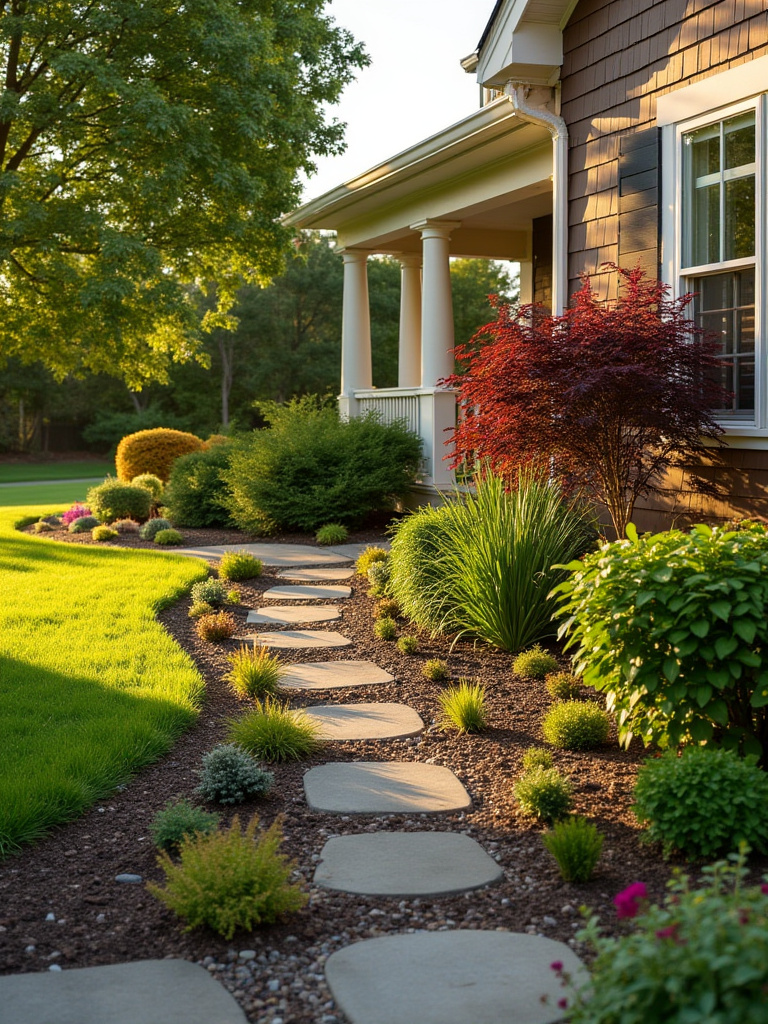
The key lies in selecting plants whose mature sizes complement rather than overwhelm your home’s proportions. Evergreen shrubs provide consistent structure throughout the seasons, while deciduous plants offer seasonal color changes and interesting winter branching patterns. Consider how different textures—the fine needles of dwarf conifers, the broad leaves of hydrangeas, the architectural forms of ornamental grasses—can create visual interest even when flowers aren’t in bloom. Proper spacing prevents the common mistake of overcrowding, which can trap moisture against the house and create maintenance headaches.
- Evergreen backbone plants ensure year-round structure and privacy
- Seasonal accent plants provide bursts of color and fragrance
- Varied heights and textures create visual depth and interest
- Proper spacing allows for mature growth and air circulation
The artistry in foundation planting comes from understanding how these living elements will evolve over time, creating compositions that improve with age rather than requiring constant editing.
5. Make a Statement with Your Front Door’s Personality
Your front door serves as more than an entrance—it’s the punctuation mark that completes your home’s exterior sentence. The transformation that occurs when you refresh this crucial element never fails to surprise homeowners with its immediate impact. Whether your home calls for a bold navy that plays beautifully against warm brick, a classic forest green that honors traditional architecture, or a sophisticated charcoal that adds contemporary edge, the right color choice can shift your entire home’s personality while maintaining its authentic character.
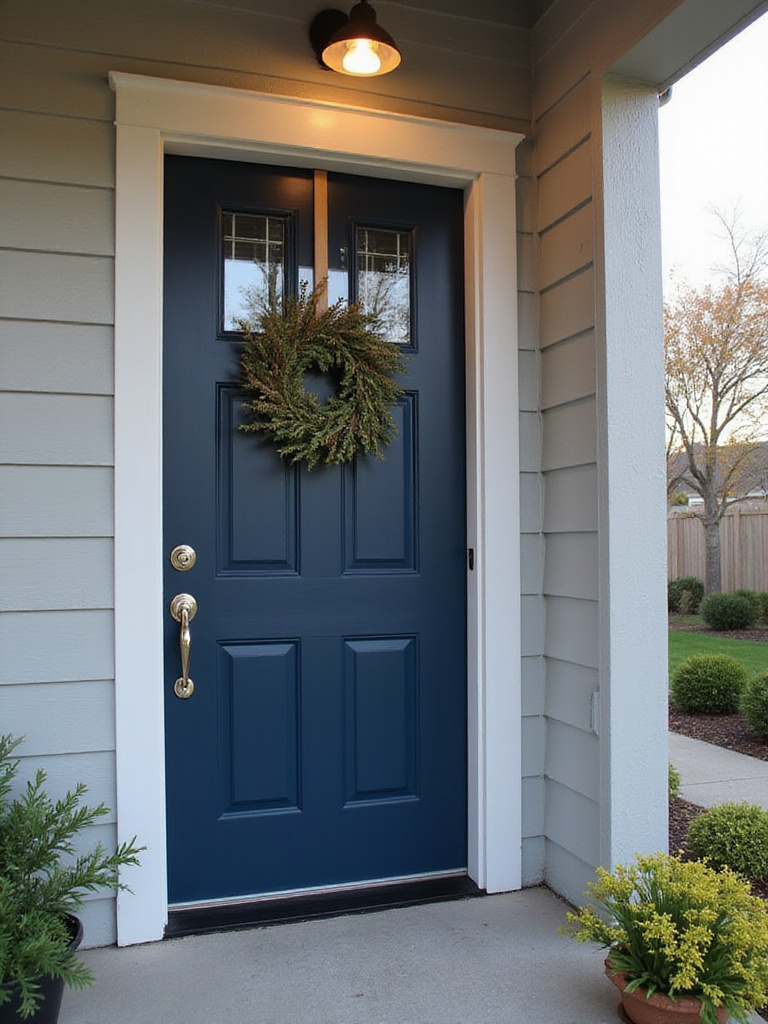
The process involves more than simply applying paint; it’s about creating a cohesive statement that includes hardware, lighting, and seasonal accents. Quality exterior paint designed for your climate ensures longevity, while updated hardware—perhaps brushed brass for vintage charm or matte black for contemporary appeal—adds tactile richness that visitors notice immediately. Don’t overlook the importance of proper surface preparation; a door that’s been thoroughly cleaned, sanded, and primed will hold its finish beautifully for years to come.
Beyond color and hardware, consider how lighting enhances your entrance during evening hours, how a carefully chosen doormat extends the welcome, and how seasonal wreaths or plantings can keep the entrance feeling fresh throughout the year.
6. Extend Your Home’s Welcome with Strategic Lighting
Thoughtful outdoor lighting transforms your front yard from a space that disappears at sunset into one that maintains its appeal around the clock. The most effective lighting schemes layer different types of illumination: path lights that ensure safe navigation, accent lights that highlight architectural features or specimen plants, and ambient lighting that creates a warm, welcoming atmosphere. In my experience working with vintage homes, the key lies in choosing fixtures that complement your home’s architectural period while providing modern LED efficiency and smart controls.
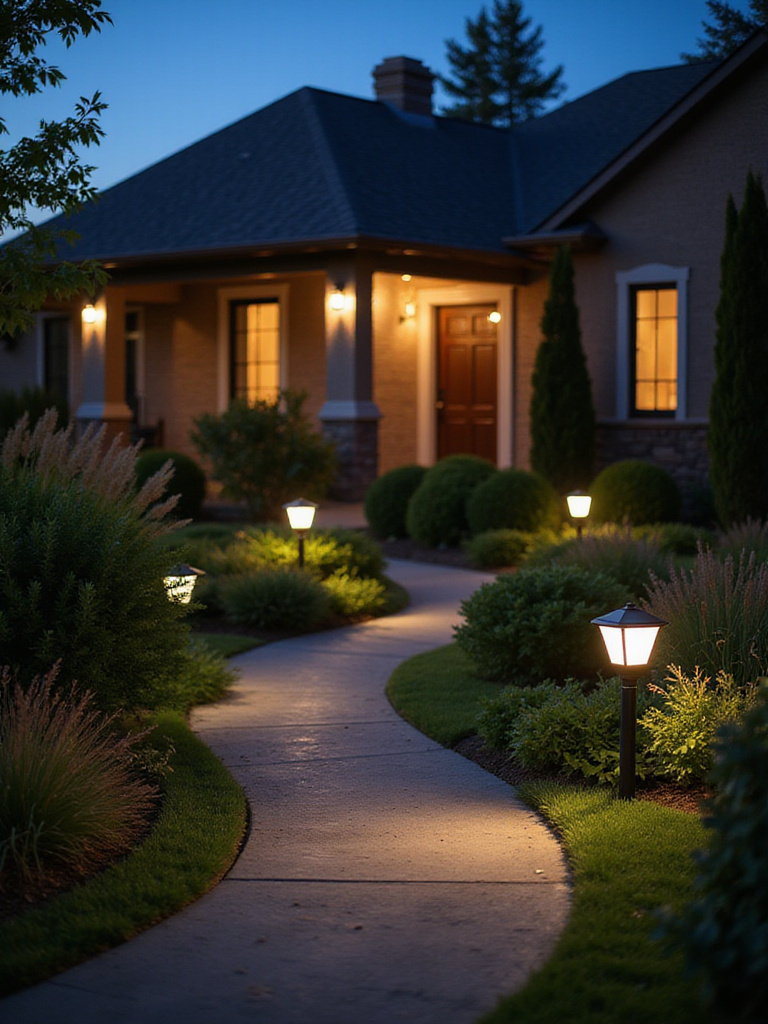
Safety considerations merge seamlessly with aesthetic goals when lighting is planned properly. Well-lit pathways and steps dramatically reduce the risk of accidents, while strategic placement near entry points and potential hiding spots enhances security without creating harsh, unwelcoming brightness. The warm color temperature of 2700K to 3000K creates inviting ambiance, while cooler temperatures work better for task lighting around house numbers or mailboxes where visibility is paramount.
- Path lighting ensures safe navigation along walkways and steps
- Accent lighting highlights architectural details and landscape features
- Security lighting with motion sensors provides safety without constant brightness
- Smart controls allow for scheduling and remote adjustment via smartphone
The magic happens when these elements work together to create layers of light that reveal your home’s character while providing practical benefits that extend well beyond mere appearance.
7. Signal Contemporary Care with Updated House Numbers and Mailbox
The details that greet visitors before they even reach your front door speak volumes about the care and attention given to your entire property. Modern house numbers and a thoughtfully chosen mailbox represent small investments that yield significant returns in perceived value and curb appeal. These elements work best when they echo your home’s architectural language—sleek stainless steel numbers suit mid-century modern homes beautifully, while traditional brass or bronze complements colonial and craftsman styles.
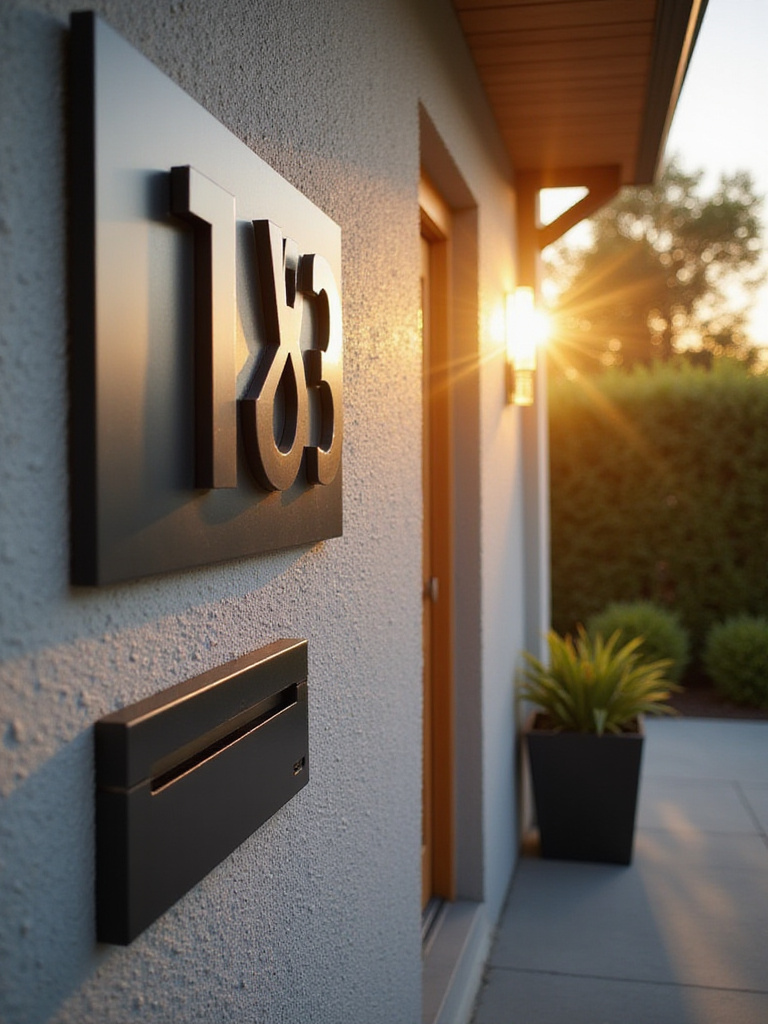
Visibility remains paramount, especially for emergency services and delivery personnel. Numbers should be large enough to read easily from the street, positioned where they won’t be obscured by plantings or shadows, and illuminated for nighttime visibility. For mailboxes, consider whether a wall-mounted design integrates better with your home’s architecture or if a post-mounted option provides better street visibility. The materials and finishes you choose should coordinate with existing exterior elements like light fixtures and door hardware.
The installation process offers opportunities to enhance functionality—perhaps adding a small spotlight to illuminate house numbers, or positioning the mailbox where it’s easily accessible for both postal workers and residents without compromising the landscape design.
8. Add Instant Vibrancy with Strategic Container Gardens
Container gardens offer unparalleled flexibility for homeowners who want to refresh their front yard’s appearance seasonally or experiment with plant combinations before committing to permanent installations. The most successful container displays follow the classic “thriller, filler, spiller” formula: a tall, dramatic plant for height and structure, medium-sized plants that fill out the composition, and trailing varieties that soften the container’s edges. This approach creates dynamic arrangements that provide visual interest from multiple angles while ensuring each plant has the space and conditions it needs to thrive.
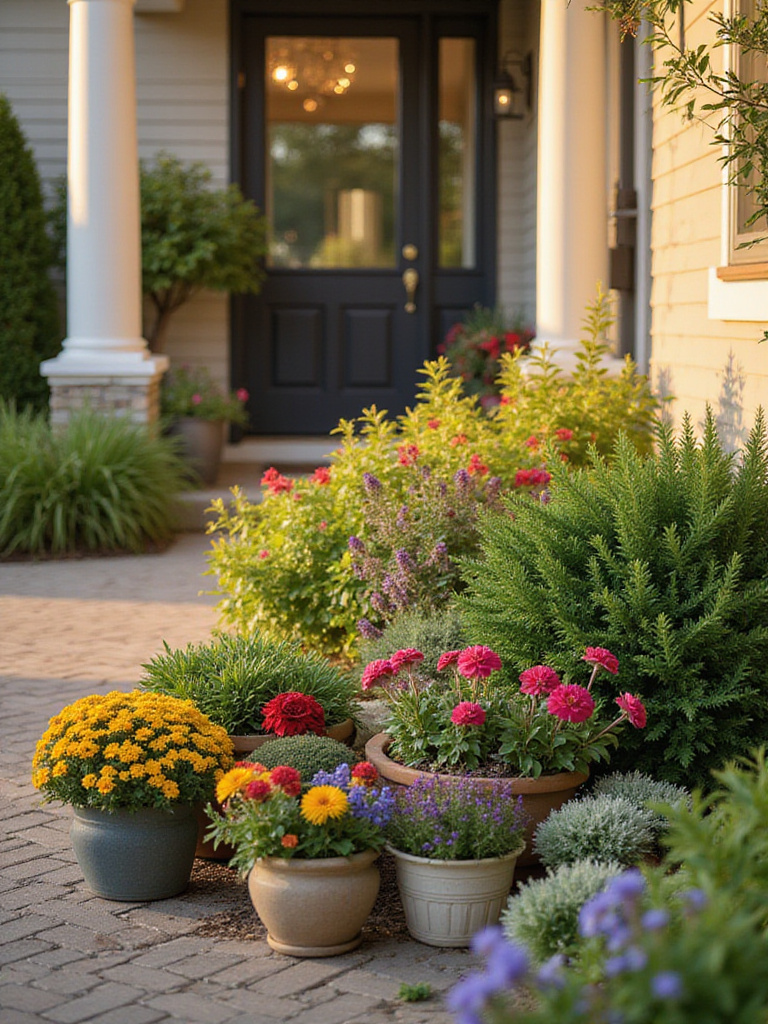
The containers themselves become part of the design statement, whether you choose weathered terracotta that develops beautiful patina over time, sleek fiberglass planters that suit contemporary architecture, or vintage-inspired ceramic pots that add personality and charm. Proper drainage remains crucial—containers without adequate drainage holes will quickly become waterlogged, leading to root rot and plant failure. Quality potting mix, rather than garden soil, provides the drainage and aeration that container plants require.
- Seasonal rotation keeps displays fresh and appropriate for current growing conditions
- Groupings of odd numbers create more visually appealing arrangements
- Varied container heights add dimension and visual interest
- Coordinated color schemes tie into your home’s existing palette
The beauty of this approach lies in its adaptability, allowing you to experiment with different plant combinations and seasonal themes while maintaining consistent visual impact.
9. Create Visual Anchors with Compelling Focal Points
Every memorable front yard benefits from a strong focal point that draws the eye and provides a sense of destination within the landscape. The most effective focal points feel both intentional and natural, whether it’s a specimen tree with exceptional seasonal interest, a carefully positioned sculpture that reflects your personal style, or a water feature that adds movement and sound to the space. The key lies in choosing elements that complement your home’s architectural character while providing visual weight appropriate to the surrounding space.

Scale and proportion determine whether a focal point enhances or overwhelms your landscape. A focal point that’s too small will be overlooked, while one that’s too large can dominate the space uncomfortably. Consider sight lines from multiple vantage points—the street, your front door, and key windows—to ensure the focal point enhances views rather than blocking them. Integration with surrounding plantings helps anchor the feature within the broader landscape design.
The most successful focal points offer interest throughout the seasons, whether through evergreen structure, changing foliage, or sculptural form that remains compelling even in winter’s stark light.
10. Unify Your Design with Thoughtful Color Coordination
Creating a cohesive color palette for your front yard involves more than simply choosing plants with complementary blooms—it requires understanding how foliage colors, hardscape materials, and architectural elements work together to create visual harmony. The most successful color schemes begin with your home’s existing palette, using the colors of siding, trim, roofing, and other permanent elements as the foundation for landscape choices. This approach ensures that your garden feels integrated with your home rather than applied as an afterthought.
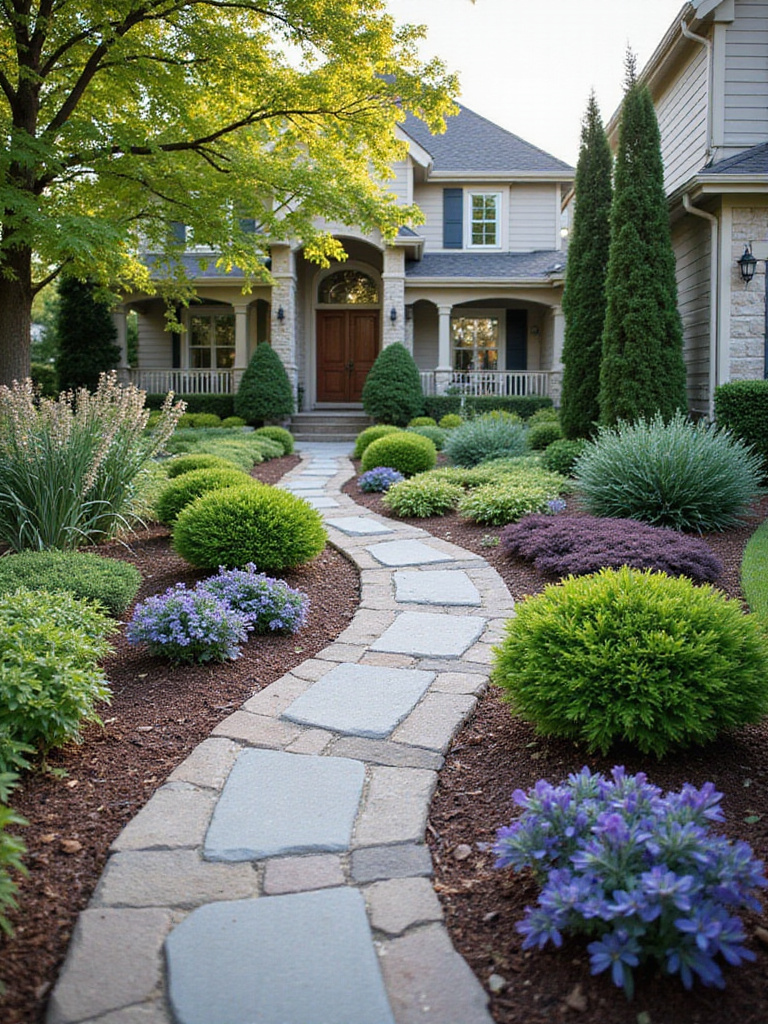
Foliage provides the most consistent color throughout the growing season, making it crucial to consider the various greens, silvers, purples, and chartreuses available in plant selections. These colors serve as the backdrop for seasonal flowers and changing elements, providing continuity that holds the design together even when specific blooms come and go. The interplay between warm and cool tones can create different moods—warm colors advance visually and create energy, while cool colors recede and provide calm.
- Monochromatic schemes using various shades of one color create sophisticated subtlety
- Analogous combinations pair neighboring colors for gentle, harmonious transitions
- Complementary contrasts use opposite colors for vibrant, energetic displays
- Neutral foundations provide flexibility for seasonal accent colors
Understanding how these relationships work allows you to create landscapes that feel both dynamic and restful, providing visual interest without overwhelming chaos.
11. Embrace Sustainability with Drought-Tolerant Plant Selections
Water-wise gardening represents both environmental responsibility and practical wisdom, creating landscapes that thrive with minimal irrigation while offering unique textures, colors, and forms often unavailable in traditional plantings. The misconception that drought-tolerant means boring or monochromatic couldn’t be further from the truth—these plants offer some of the most interesting architectural forms and unexpected color combinations available to gardeners. From the silvery foliage of artemisia to the sculptural presence of agaves, these plants bring distinctive character to front yard designs.

The key to successful drought-tolerant landscaping lies in proper plant selection for your specific climate and soil conditions, combined with appropriate soil preparation and establishment care. Even water-wise plants require consistent moisture during their first growing season while establishing root systems. Once established, these plants often require less maintenance than traditional landscape plants, freeing up time and resources while providing habitat for beneficial insects and birds.
- Native plants are naturally adapted to local climate conditions
- Mediterranean species offer drought tolerance with classic garden appeal
- Ornamental grasses provide movement and seasonal interest with minimal water needs
- Succulents create architectural focal points while requiring minimal care
The transformation that occurs when homeowners embrace these plants often surprises them with the richness and diversity possible within water-wise gardening approaches.
12. Define Spaces and Enhance Privacy with Strategic Shrub Placement
Shrubs serve as the landscape’s middle layer, bridging the gap between ground-level plantings and overhead tree canopies while providing structure, privacy, and seasonal interest. Strategic placement can transform open, undefined spaces into intimate outdoor rooms while screening undesirable views and reducing noise from nearby streets or neighbors. The most effective shrub selections offer multiple seasons of interest—perhaps spring flowers, summer foliage, fall color, and winter berries or interesting bark texture.

Understanding mature sizes prevents the common mistake of overcrowding, which leads to poor air circulation, increased disease pressure, and the need for constant pruning to maintain appropriate scale. Fast-growing species provide quick results but may require more maintenance, while slower-growing varieties often develop better structure and longevity. Consider how different growth habits—upright, spreading, or weeping—can create varied visual effects within your landscape composition.
The installation process benefits from proper soil preparation and adequate spacing, allowing each plant to develop its natural form while contributing to the overall design intent.
13. Extend Your Living Space with Inviting Seating Areas
A thoughtfully placed bench or seating area transforms your front yard from a space that’s merely viewed to one that invites lingering and engagement. The most successful front yard seating creates a sense of outdoor room while maintaining appropriate scale for the space and architectural context. Whether it’s a classic garden bench positioned to take advantage of morning sun or a more contemporary seating arrangement that encourages conversation, these elements signal hospitality while providing practical benefits for homeowners and visitors.
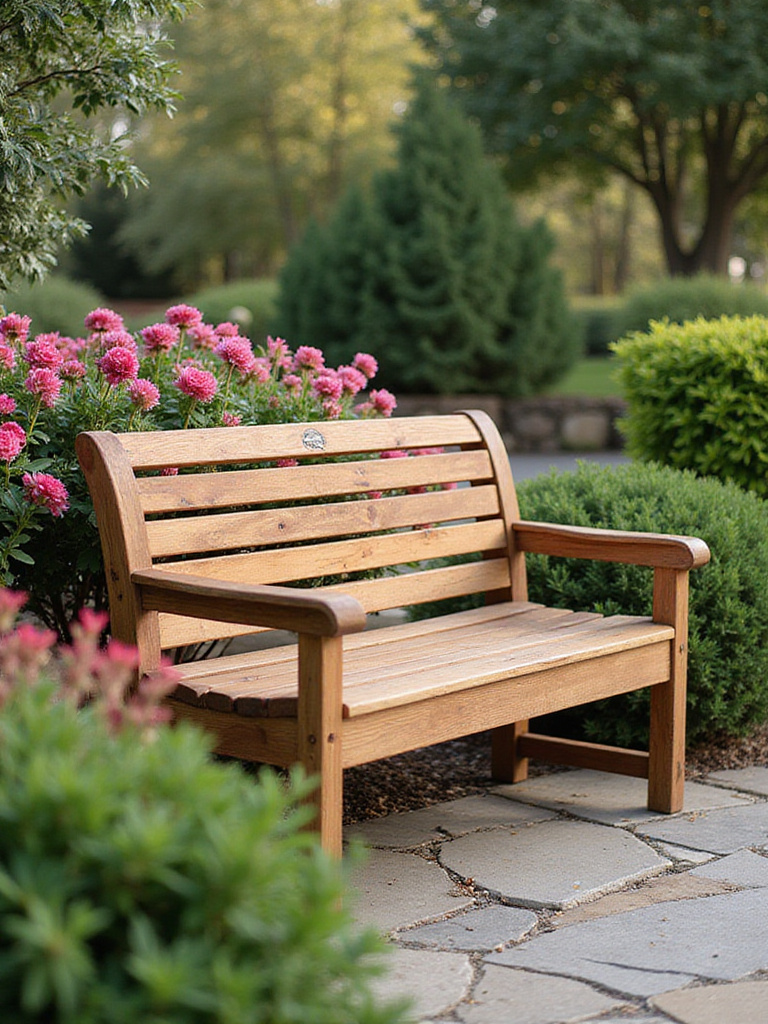
Material selection should consider both durability and aesthetic compatibility with your home’s character. Teak develops beautiful silver-gray patina over time, wrought iron offers classic elegance with proper maintenance, and contemporary materials like powder-coated aluminum provide low-maintenance options in various colors and styles. Position seating to take advantage of pleasant views while providing some sense of enclosure or backing for comfort and security.
The surrounding landscape can enhance seating areas through fragrant plantings, privacy screening, or seasonal interest that makes the space appealing throughout the year.
14. Add Tranquility with Gentle Water Features
The sound of moving water has an almost magical ability to transform outdoor spaces, masking unwanted noise while creating a sense of tranquility and sophistication. Small water features designed for front yards—bubbling fountains, disappearing waterfalls, or simple basin features—provide these benefits without overwhelming modest spaces or requiring extensive maintenance. The key lies in selecting features that complement your home’s architectural style while providing the gentle sounds and visual interest that make outdoor spaces more engaging.
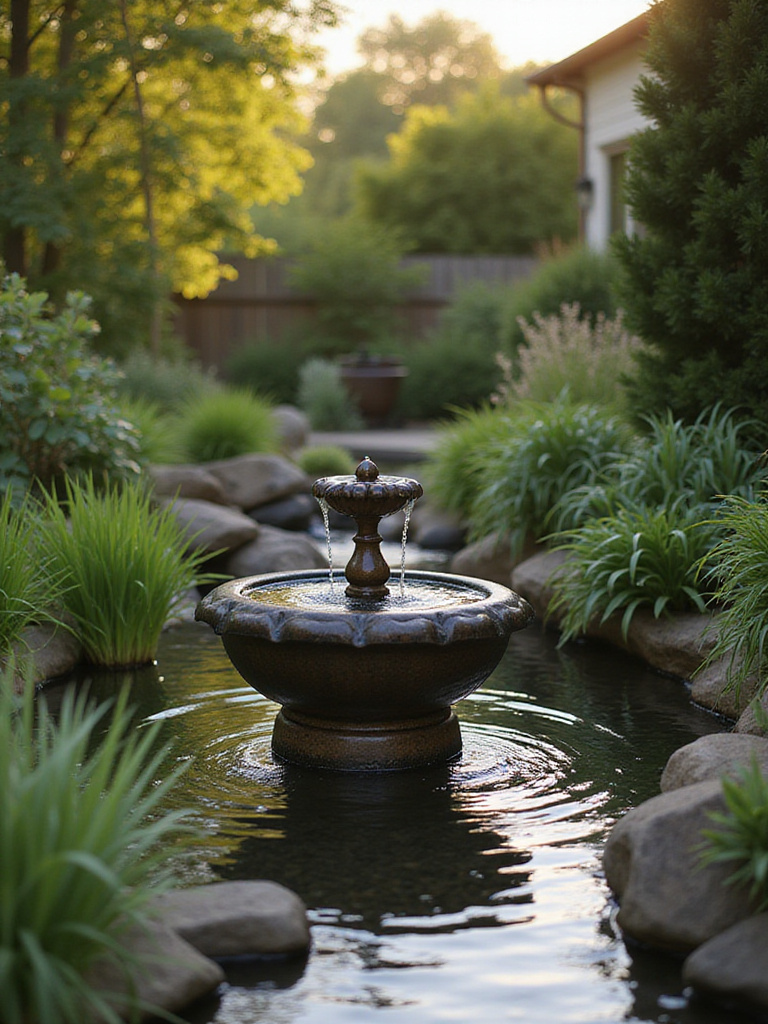
Self-contained features offer the easiest installation and maintenance, requiring only electrical connections for pumps and occasional water additions. The sound should be pleasant and subtle rather than overwhelming—a gentle babble rather than a rushing torrent. Consider how the feature will look during winter months when it may not be operating, ensuring that the structural elements remain attractive even when the water isn’t flowing.
Surrounding plantings can enhance water features while providing habitat for birds and beneficial insects attracted to the water source.
15. Maintain Pristine Garden Beds with Fresh Mulch Applications
Quality mulch serves multiple functions in front yard landscapes: suppressing weeds, conserving soil moisture, moderating soil temperature, and providing a clean, finished appearance that signals careful maintenance. The visual impact of fresh mulch is immediate and dramatic, transforming tired-looking beds into crisp, well-maintained landscapes. Beyond aesthetics, proper mulching reduces maintenance time significantly by suppressing weeds and reducing watering needs.
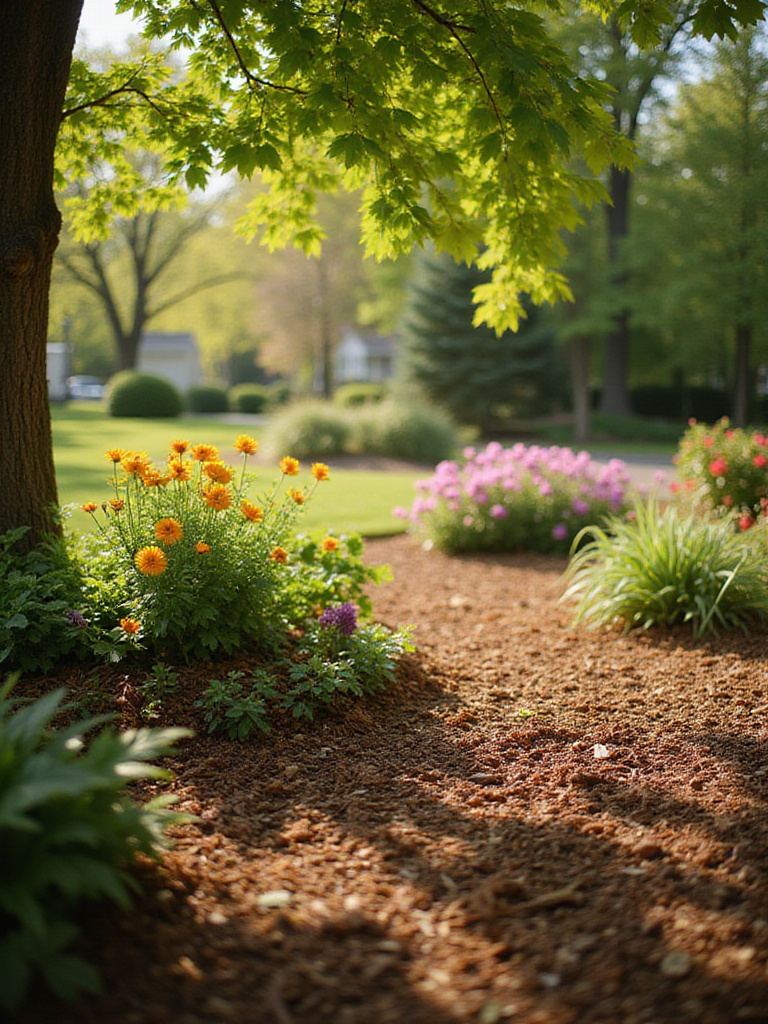
Organic mulches like shredded bark, wood chips, or pine needles offer the additional benefit of improving soil structure as they decompose, feeding beneficial soil organisms and gradually releasing nutrients. The key lies in applying appropriate depth—typically 2 to 4 inches—while keeping mulch several inches away from plant stems and tree trunks to prevent moisture-related problems and pest issues.
- Shredded bark mulch provides classic appearance and good weed suppression
- Wood chips offer economical coverage for larger areas
- Pine needles work well for acid-loving plants and sloped areas
- Gravel mulches provide permanent solutions for drought-tolerant plantings
The annual refresh of mulch beds provides an opportunity to assess plant health, adjust irrigation, and make seasonal adjustments to maintain optimal growing conditions.
16. Maintain Year-Round Interest with Seasonal Plant Rotations
The most dynamic front yards evolve throughout the seasons, offering fresh displays that keep the landscape feeling current and well-tended. Seasonal plant rotations, particularly in containers and key focal beds, allow homeowners to highlight different colors, textures, and forms as growing conditions change. This approach ensures that your front yard never looks tired or neglected, providing continuous visual interest that enhances curb appeal throughout the year.
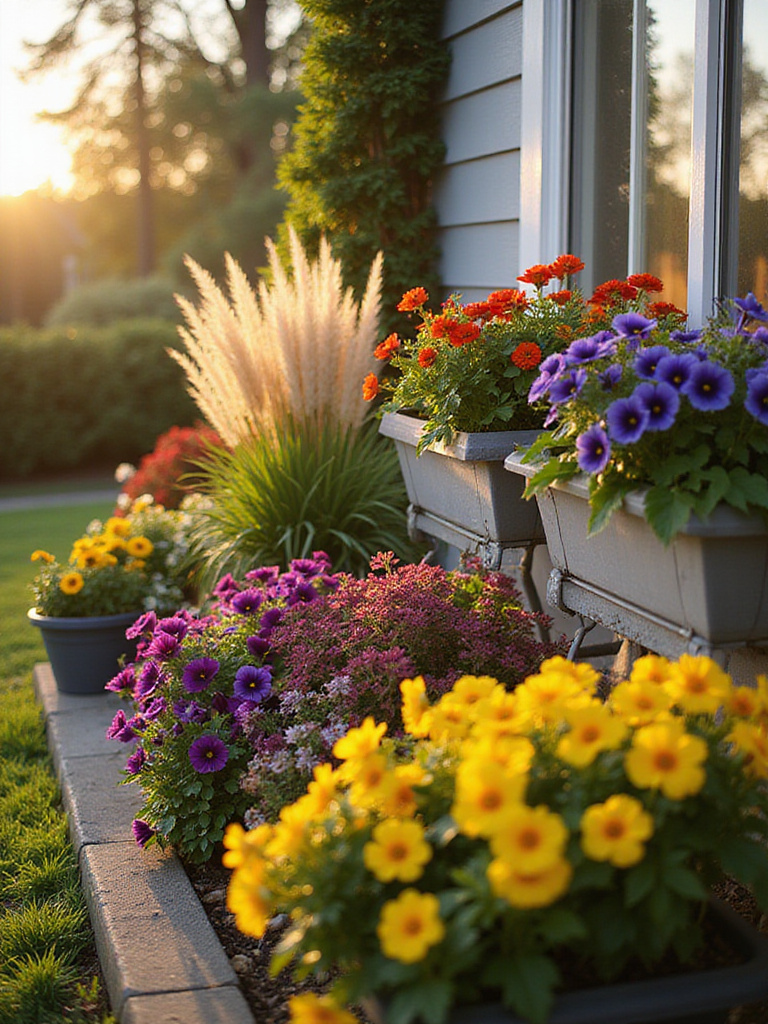
Success with seasonal rotations requires understanding which plants thrive in current conditions while planning ahead for upcoming seasons. Spring might feature cool-season annuals like pansies and primrose, summer could showcase heat-tolerant varieties like calibrachoa and coleus, fall might highlight chrysanthemums and ornamental kale, while winter containers could feature evergreen arrangements with seasonal berries or interesting branching patterns.
The investment in seasonal plants pays dividends in maintained curb appeal and the flexibility to experiment with different color combinations and design approaches without long-term commitments.
17. Blend Beauty and Function with Edible Landscape Elements
Incorporating edible plants into front yard designs challenges traditional boundaries between ornamental and productive gardening, creating landscapes that are both beautiful and functional. Many edible plants offer exceptional ornamental value—the silvery foliage of herbs like sage and lavender, the architectural forms of artichokes, the seasonal interest of blueberry bushes with their spring flowers, summer fruit, and fall color. The key lies in treating these plants as design elements first, considering their visual contribution to the overall landscape composition.

Successful edible front yards require careful plant selection to ensure year-round appeal and appropriate maintenance levels. Perennial herbs and fruit-bearing shrubs provide consistent structure, while annual vegetables can be rotated seasonally in dedicated beds or containers. Consider how these plants will look during dormant seasons and plan accordingly with evergreen companions or structural elements that maintain visual interest.
- Herb gardens provide fragrance and culinary value with minimal maintenance
- Berry bushes offer spring flowers, summer fruit, and fall foliage color
- Ornamental vegetables like Swiss chard and kale provide colorful foliage
- Fruit trees create overhead canopy with seasonal flowers and edible harvests
The integration of edible elements requires balancing productive goals with aesthetic considerations, ensuring that the landscape remains attractive even when plants are being harvested.
18. Optimize Plant Health with Smart Irrigation Technology
Modern irrigation technology offers unprecedented control over watering schedules, allowing homeowners to maintain healthy landscapes while conserving water and reducing maintenance time. Smart controllers adjust watering based on weather conditions, soil moisture levels, and plant needs, eliminating the guesswork and waste associated with traditional timer-based systems. This technology proves particularly valuable in regions with variable weather patterns or water restrictions.
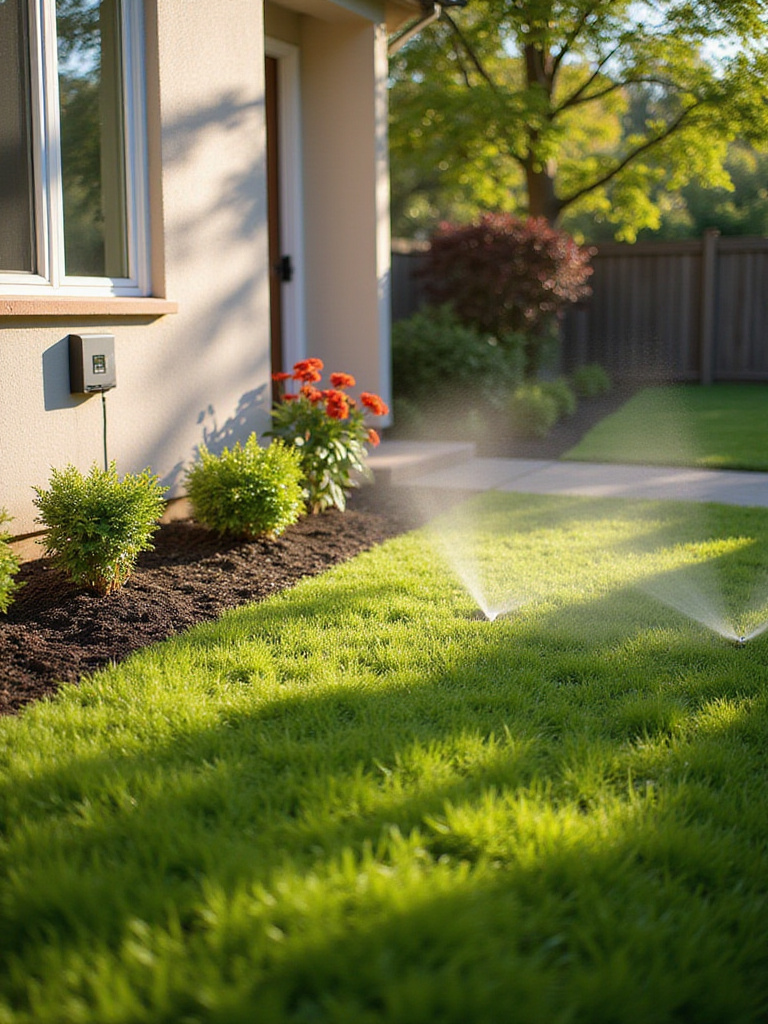
The most effective smart irrigation systems incorporate multiple data sources—local weather stations, soil moisture sensors, and plant-specific requirements—to create customized watering schedules that adapt automatically to changing conditions. Installation typically involves replacing existing controllers with smart versions and configuring zones based on plant types, sun exposure, and soil conditions. The initial setup investment pays dividends through reduced water bills and healthier plants.
Professional installation ensures proper zone configuration and system calibration, maximizing the benefits of smart technology while avoiding common mistakes that can lead to over or under-watering.
19. Create Resilient Beauty with Xeriscaping Principles
Xeriscaping represents a comprehensive approach to landscape design that prioritizes water conservation while creating visually compelling outdoor spaces. This methodology goes beyond simply selecting drought-tolerant plants to encompass soil improvement, efficient irrigation, appropriate plant groupings, and strategic use of hardscape elements. The result is landscapes that require significantly less water and maintenance while offering unique aesthetic qualities often unavailable in traditional gardening approaches.
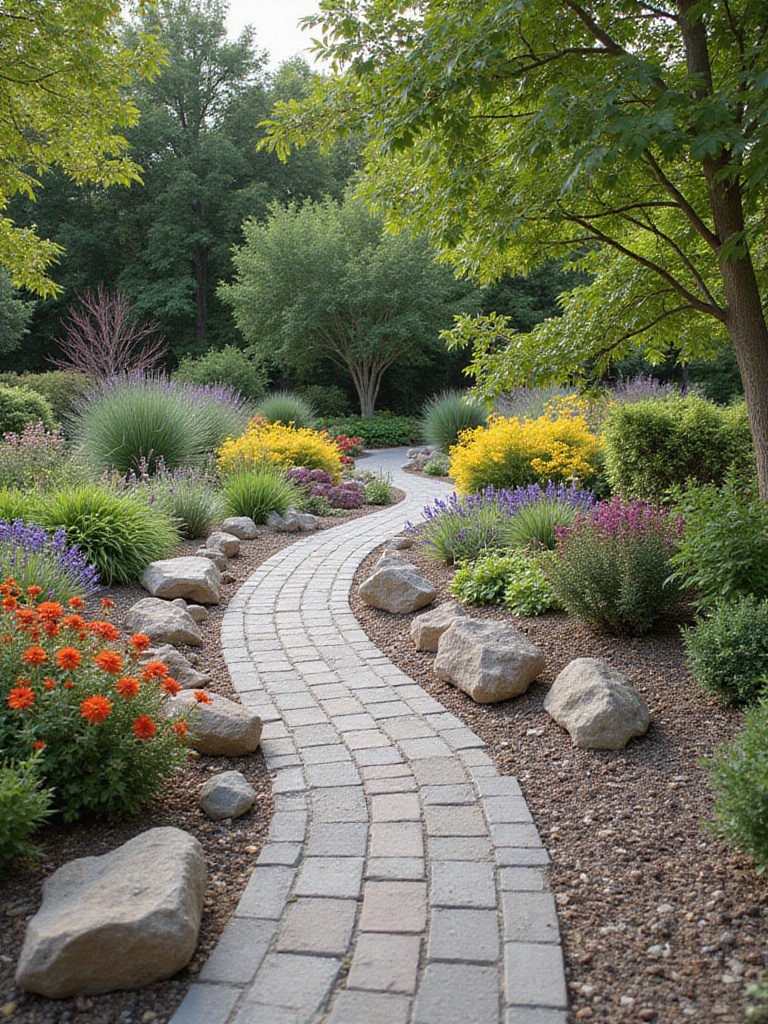
The principles of xeriscaping include improving soil drainage and water retention, grouping plants with similar water needs, using mulch to conserve moisture, and incorporating hardscape elements that complement rather than compete with planted areas. Native and adapted plants form the backbone of xeriscaped landscapes, providing habitat for local wildlife while requiring minimal supplemental irrigation once established.
- Hydrozoning groups plants with similar water requirements for efficient irrigation
- Soil amendment improves both drainage and water retention capacity
- Mulching reduces evaporation and moderates soil temperature
- Hardscape integration provides visual interest while reducing planted area
The evolution toward xeriscaping reflects growing environmental awareness combined with practical considerations of maintenance time and water costs.
20. Express Personal Style with Curated Garden Accents
Garden accents provide opportunities to inject personality and individual style into front yard designs, transforming generic landscapes into personalized expressions of the homeowner’s interests and aesthetic preferences. The most effective accents complement rather than compete with the overall design, adding visual interest without overwhelming the space. Whether it’s a carefully chosen sculpture, an antique architectural element repurposed as a planter, or a collection of vintage pottery arranged as a focal point, these elements should feel integrated rather than imposed.

Scale and placement determine whether accents enhance or detract from the overall landscape composition. Multiple small accents can create visual clutter, while a single well-chosen focal piece can provide just the right amount of personality and interest. Consider how accents will weather over time, choosing materials that develop attractive patina or maintain their appearance with minimal maintenance.
The curation process involves editing and refining, ensuring that each element contributes to the overall design intent while reflecting the homeowner’s individual style and interests.
21. Ensure Safety and Beauty with Hardscape Maintenance
Well-maintained hardscapes provide the structural foundation for successful front yard designs, ensuring safe navigation while contributing to the overall aesthetic appeal. Regular inspection and prompt repair of walkways, driveways, and other paved surfaces prevent small problems from becoming major safety hazards or expensive reconstruction projects. The visual impact of clean, well-maintained hardscapes cannot be overstated—cracked or stained surfaces immediately signal neglect and detract from even the most beautiful plantings.
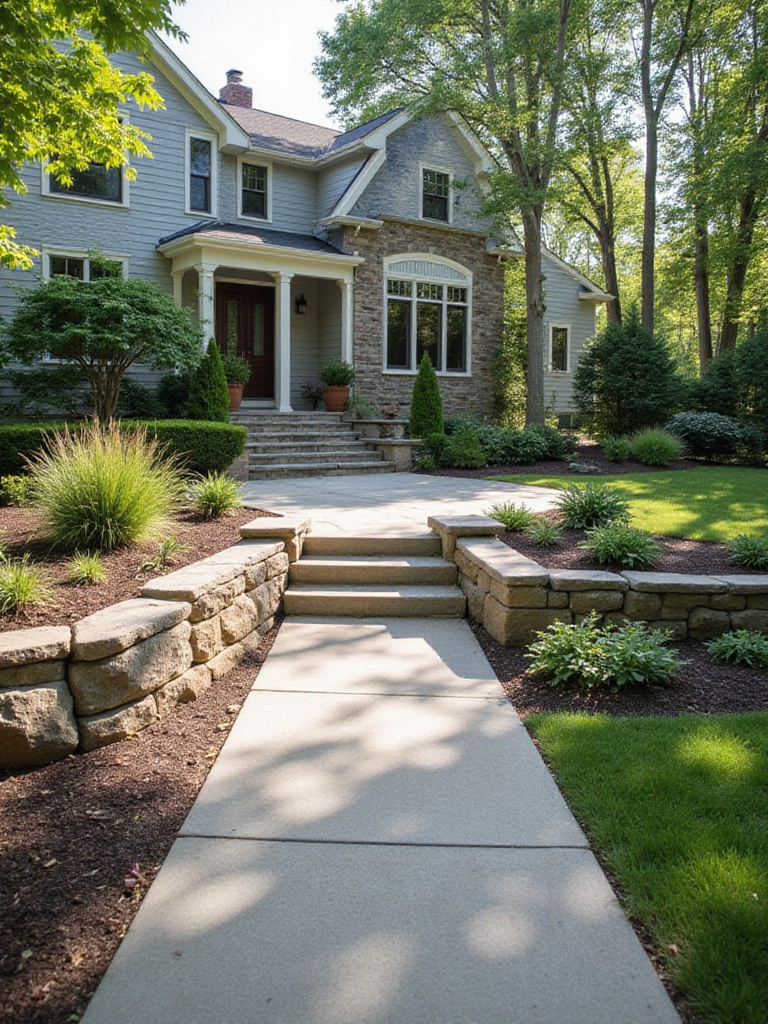
Preventive maintenance includes regular cleaning, prompt repair of minor cracks or settling, and appropriate sealing to protect surfaces from weather damage. Different materials require specific care approaches—natural stone may need periodic resealing, concrete benefits from crack repair and surface protection, while brick or paver surfaces may require periodic releveling and joint sand replacement.
The investment in hardscape maintenance pays dividends in safety, appearance, and long-term durability, protecting the substantial investment these elements represent while ensuring they continue to enhance rather than detract from curb appeal.
22. Achieve Cohesive Excellence with Professional Design Guidance
While many front yard improvements can be accomplished as DIY projects, achieving truly cohesive and sophisticated results often benefits from professional design expertise. Landscape architects and designers bring specialized knowledge of plant materials, design principles, and construction techniques that can transform good intentions into exceptional results. Their experience helps avoid costly mistakes while ensuring that individual elements work together to create unified, functional, and beautiful outdoor spaces.
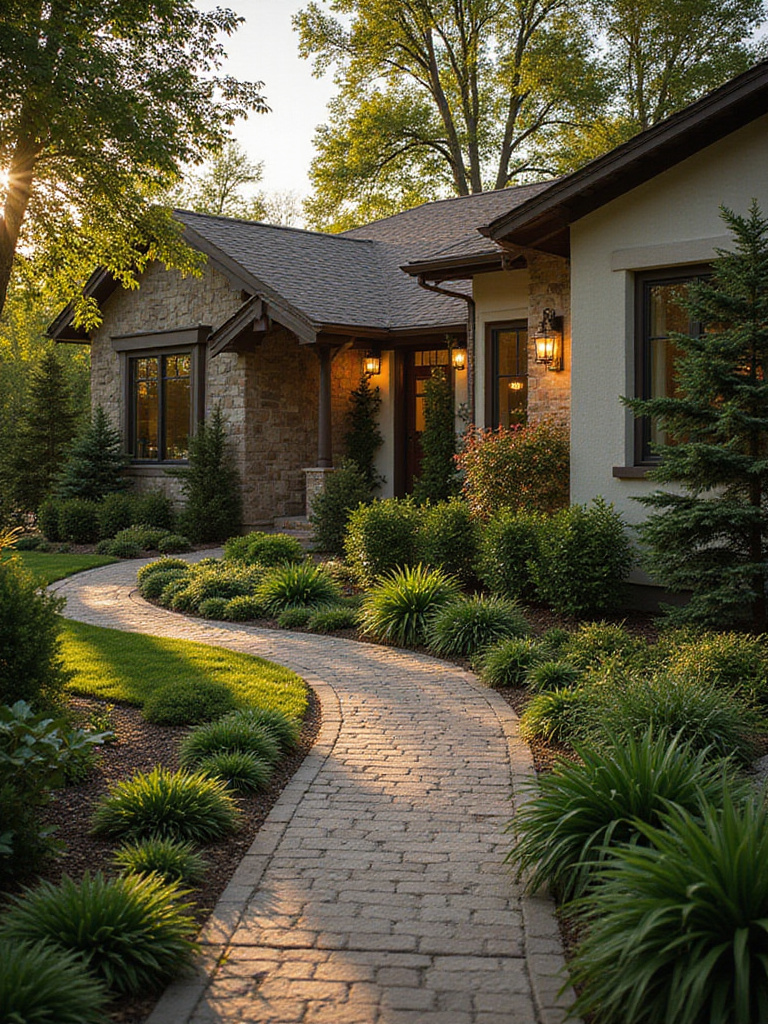
Professional design services range from consultation and master planning to complete design and installation management. The investment in professional guidance often pays for itself through improved plant selection, efficient use of space, and construction details that ensure longevity and performance. Designers also bring knowledge of local climate conditions, soil types, and maintenance requirements that can significantly impact long-term success.
The collaboration between homeowner vision and professional expertise typically yields results that exceed what either could accomplish independently, creating front yards that enhance property value while providing years of enjoyment and pride.
Conclusion
Creating a front yard that truly enhances your home’s character while serving your family’s needs requires more than following trends or copying magazine photos—it demands understanding how individual elements work together to create cohesive, functional, and beautiful outdoor spaces. These front yard ideas represent starting points for your own creative journey, whether you’re drawn to water-wise xeriscaping, seasonal container displays, or comprehensive landscape renovations that transform your property’s entire character.
The most successful front yard transformations happen gradually, allowing homeowners to experiment with different approaches while building on previous successes. Perhaps you’ll begin with strategic mowing techniques and fresh mulch, then add container gardens and updated lighting as your confidence and vision develop. Each improvement builds on the others, creating momentum that makes subsequent projects more rewarding and effective.
Remember that the best front yard ideas are those that reflect your family’s lifestyle, your home’s architectural character, and your personal aesthetic preferences. Whether your style leans toward vintage charm, contemporary sophistication, or somewhere in between, the principles of good design—appropriate scale, thoughtful plant selection, quality materials, and careful maintenance—remain constant. Start with one or two projects that excite you most, and let your front yard’s transformation unfold naturally over time, creating a space that welcomes visitors while providing daily pleasure for years to come.

